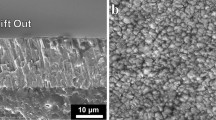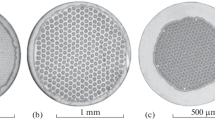Abstract
One method of producing Nb3Sn is to react a molten tin alloy with a solid niobium alloy. Using this process, the addition of zirconium and oxygen to the niobium foil has been found to dramatically reduce the Nb3Sn grain size and affect the Nb3Sn superconducting critical current properties. Nb3Sn grains grow semicoherently on the niobium alloy foil. The initial grain size is about 50 nm. These initial Nb3Sn grains coarsen rapidly to become equiaxed grains about 0.2 μm in diameter. The equiaxed Nb3Sn grains away from the Nb/Nb3Sn interface are completely surrounded by a tin alloy phase that would have been liquid at the reaction temperature. Based on transmission electron microscopy observation and electrical property characterization, it is concluded that ZrO2 clusters, less than 10 Å in size, form in the niobium alloy foil during processing. These clusters combine at the Nb/Nb3Sn interface to form ZrO2 precipitates. The ZrO2 precipitates are found in all of the Nb3Sn grains that have formed from a reaction between the liquid tin and the solid niobium at the Nb/Nb3Sn interface. The precipitates are coherent with their host Nb3Sn grains. During Nb3Sn grain growth, the ZrO2 precipitates dissolve in shrinking grains and reprecipitate in growing grains, as the migrating grain boundary intersects the precipitate. This dissolution/reprecipitation process slows the growth of Nb3Sn grains.
Similar content being viewed by others
References
J. Denny and R. Hardt: U.S. Patent 3,181,936, May 4, 1965.
D.L. Martin, M.G. Benz, CA. Bruch, and C.H. Rosner:Cryogenics, 1963, vol. 3, pp. 161–66.
J.E. Kunzler, E. Buehler, F.S.L. Hsu, and J.H. Wernick:Phys. Rev. Lett., 1961, vol. 6 (3), pp. 89–91.
M.G. Benz:IEEE Trans. Magnetics, 1966, Mag.2 (4), pp. 760–64.
M.G. Benz:Trans. TMS-A1ME, 1968, vol. 242, p. 1067–68.
R.M. Scanlan, W.A. Fietz, and E.F. Koch:J. Appl. Phys., 1975, vol. 46 (5), pp. 2244–49.
D.L. Martin and M.G. Benz:U.S Patent 3,429,032, Feb. 25, 1966.
J.S. Caslaw:Cryogenics, 1971, vol. 11, pp. 57–59.
J. Livingston:Phys. Status Solidi A, 1977, vol. 44, p. 295.
E.L. Hall, M.G. Benz, L.E. Rumaner, and K.D. Jones,Mat. Res. Soc. Symp. Proc, vol. 205, 1992.
L.E. Rumaner and M.G. Benz:Metall. Trans. A, 1994, vol. 25A, pp. 203–12.
L.E. Rumaner: M.S. Thesis, Rensselaer Polytechnic Institute, Troy, NY, 1991.
J. Bravman and R. Sinclair:J. Electron Microsc. Tech., 1984, vol. 1, p. 53.
T.B. Massalski, ed.:Binary Alloy Phase Diagrams, ASM International, Materials Park, OH, 1987, vol. 3, p. 2771.
H.J. Moller: Case Western Reserve University, Cleveland, OH, unpublished research, 1990.
P.M. Bunn, D.G. Cummings, and H.W. Leavenworth, Jr.:J. Appl. Phys., 1962, vol. 33 (10), pp. 3009–13.
R.M. Bonesteel, D.J. Rowcliffe, and T.E. Tietz:Trans. AIME, 1968, suppl.9, pp. 597–602.
C.T. Liu, R.W. Carpenter, and H. Inouye:Metall. Trans. A, 1975, vol. 6A, pp. 419–21. $
Author information
Authors and Affiliations
Additional information
Formerly with GE Corporate Research & Development, Schenectady, NY,
Rights and permissions
About this article
Cite this article
Rumaner, L.E., Benz, M.G. & Hall, E.L. The role of oxygen and zirconium in the formation and growth of Nb3sn grains. Metall Mater Trans A 25, 213–219 (1994). https://doi.org/10.1007/BF02646689
Received:
Issue Date:
DOI: https://doi.org/10.1007/BF02646689




